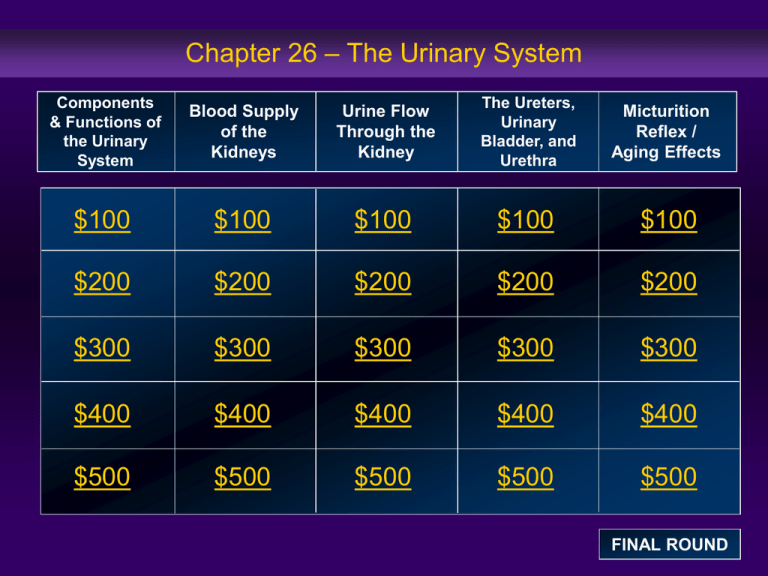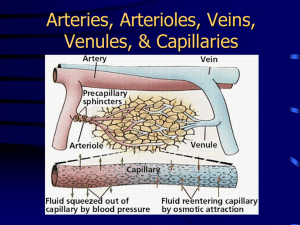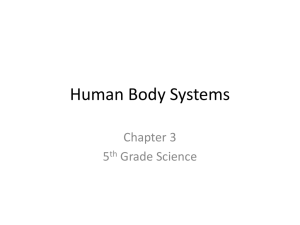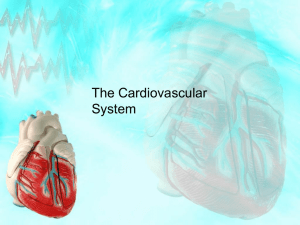26_QuizShowQuestions
advertisement

Chapter 26 – The Urinary System Components & Functions of the Urinary System Blood Supply of the Kidneys Urine Flow Through the Kidney The Ureters, Urinary Bladder, and Urethra Micturition Reflex / Aging Effects $100 $100 $100 $100 $100 $200 $200 $200 $200 $200 $300 $300 $300 $300 $300 $400 $400 $400 $400 $400 $500 $500 $500 $500 $500 FINAL ROUND Topic 1: $100 Question Which of the following functions to conduct semen to the exterior in males? a. ureter b. collecting duct c. urethra d. papillary duct ANSWER BACK TO GAME Topic 1: $100 Answer Which of the following functions to conduct semen to the exterior in males? a. ureter b. collecting duct c. urethra d. papillary duct BACK TO GAME Topic 1: $200 Question Which of the following structures faces the renal cortex? a. base of each pyramid b. renal papillae c. tip of each pyramid d. renal pelvis ANSWER BACK TO GAME Topic 1: $200 Answer Which of the following structures faces the renal cortex? a. base of each pyramid b. renal papillae c. tip of each pyramid d. renal pelvis BACK TO GAME Topic 1: $300 Question Each kidney has roughly ____ nephrons, with a combined length of about ____. a. 1.25 million, 85 miles b. 0.75 million, 170 miles c. 1.25 million, 170 miles d. 0.75 million, 85 miles ANSWER BACK TO GAME Topic 1: $300 Answer Each kidney has roughly ____ nephrons, with a combined length of about ____. a. 1.25 million, 85 miles b. 0.75 million, 170 miles c. 1.25 million, 170 miles d. 0.75 million, 85 miles BACK TO GAME Topic 1: $400 Question Which of the following do not pass through the hilum and branch within the renal sinus? a. renal blood vessels and nerves b. lymphatic vessels c. urethra d. ureter ANSWER BACK TO GAME Topic 1: $400 Answer Which of the following do not pass through the hilum and branch within the renal sinus? a. renal blood vessels and nerves b. lymphatic vessels c. urethra d. ureter BACK TO GAME Topic 1: $500 Question On gross dissection, which of the following can be visualized? a. The anterior surface of the left kidney is covered by the liver, hepatic flexure of the colon, and duodenum. b. The anterior surface of the left kidney is covered by the spleen, stomach, pancreas, jejunum, and splenic flexure of the colon. c. The medial surface of each kidney is capped by a suprarenal gland. d. The kidneys lie between the muscles of the dorsal body wall and the visceral peritoneum in a retroperitoneal position. ANSWER BACK TO GAME Topic 1: $500 Answer On gross dissection, which of the following can be visualized? a. The anterior surface of the left kidney is covered by the liver, hepatic flexure of the colon, and duodenum. b. The anterior surface of the left kidney is covered by the spleen, stomach, pancreas, jejunum, and splenic flexure of the colon. c. The medial surface of each kidney is capped by a suprarenal gland. d. The kidneys lie between the muscles of the dorsal body wall and the visceral peritoneum in a retroperitoneal position. BACK TO GAME Topic 2: $100 Question Which of the following vessels parallel the boundary between the cortex and medulla of the kidney and give rise to a number of interlobular arteries? a. afferent arterioles b. cortical radiate arteries c. arcuate arteries d. interlobar arteries ANSWER BACK TO GAME Topic 2: $100 Answer Which of the following vessels parallel the boundary between the cortex and medulla of the kidney and give rise to a number of interlobular arteries? a. afferent arterioles b. cortical radiate arteries c. arcuate arteries d. interlobar arteries BACK TO GAME Topic 2: $200 Question Which of the following vessels branch from each cortical radiate artery to supply individual nephrons? a. efferent arterioles b. segmental arteries c. interlobular arteries d. afferent arterioles ANSWER BACK TO GAME Topic 2: $200 Answer Which of the following vessels branch from each cortical radiate artery to supply individual nephrons? a. efferent arterioles b. segmental arteries c. interlobular arteries d. afferent arterioles BACK TO GAME Topic 2: $300 Question From the glomerulus, the efferent arteriole enters which vessel(s)? a. peritubular capillaries b. interlobular veins c. venules d. renal vein ANSWER BACK TO GAME Topic 2: $300 Answer From the glomerulus, the efferent arteriole enters which vessel(s)? a. peritubular capillaries b. interlobular veins c. venules d. renal vein BACK TO GAME Topic 2: $400 Question Which process occurs across the walls of the glomerular capillaries? a. reabsorption b. secretion c. excretion d. filtration ANSWER BACK TO GAME Topic 2: $400 Answer Which process occurs across the walls of the glomerular capillaries? a. reabsorption b. secretion c. excretion d. filtration BACK TO GAME Topic 2: $500 Question Which of the following indicates the correct flow of renal circulation? a. renal artery → cortical radiate arteries → arcuate arteries → interlobar arteries b. arcuate arteries → cortical radiate arteries → afferent arterioles → glomerulus c. efferent arteriole → peritubular capillaries → interlobular veins → venules → interlobar veins ANSWER d. (a) and (b) BACK TO GAME Topic 2: $500 Answer Which of the following indicates the correct flow of renal circulation? a. renal artery → cortical radiate arteries → arcuate arteries → interlobar arteries b. arcuate arteries → cortical radiate arteries → afferent arterioles → glomerulus c. efferent arteriole → peritubular capillaries → interlobular veins → venules → interlobar veins d. (a) and (b) BACK TO GAME Topic 3: $100 Question Which of the following nephron segments functions in the secretion of ions, acids, drugs, and toxins? a. papillary duct b. connecting tubules and collecting duct c. distal convoluted tubule d. proximal convoluted tubule ANSWER BACK TO GAME Topic 3: $100 Answer Which of the following nephron segments functions in the secretion of ions, acids, drugs, and toxins? a. papillary duct b. connecting tubules and collecting duct c. distal convoluted tubule d. proximal convoluted tubule BACK TO GAME Topic 3: $200 Question Mesangial cells are/do not: a. engulf organic materials that might otherwise clog the dense layer. b. situated between the endothelial cells of adjacent capillaries, which are encircled by the clear layer of the basal lamina. c. regulate the diameters of the glomerular capillaries. d. provide physical support for the glomerular capillaries. ANSWER BACK TO GAME Topic 3: $200 Answer Mesangial cells are/do not: a. engulf organic materials that might otherwise clog the dense layer. b. situated between the endothelial cells of adjacent capillaries, which are encircled by the clear layer of the basal lamina. c. regulate the diameters of the glomerular capillaries. d. provide physical support for the glomerular capillaries. BACK TO GAME Topic 3: $300 Question The glomerular capillaries are ____ capillaries with pores ranging from ____. a. discontinuous, 60-100 μm b. fenestrated, 60-100 μm c. fenestrated, 60-100 nm d. discontinuous, 200-500 nm ANSWER BACK TO GAME Topic 3: $300 Answer The glomerular capillaries are ____ capillaries with pores ranging from ____. a. discontinuous, 60-100 μm b. fenestrated, 60-100 μm c. fenestrated, 60-100 nm d. discontinuous, 200-500 nm BACK TO GAME Topic 3: $400 Question The distal segments of the nephron are not responsible for which of the following functions? a. secretion of more than 80% of the water in the filtrate b. secretion of all of the useful organic substrates from the filtrate c. secretion into the filtrate of waste products that were missed by filtration d. (a) and (b) ANSWER BACK TO GAME Topic 3: $400 Answer The distal segments of the nephron are not responsible for which of the following functions? a. secretion of more than 80% of the water in the filtrate b. secretion of all of the useful organic substrates from the filtrate c. secretion into the filtrate of waste products that were missed by filtration d. (a) and (b) BACK TO GAME Topic 3: $500 Question Which of the following nephron components lies almost directly opposite the vascular pole of the renal corpuscle, at its tubular pole? a. papillary duct b. proximal convoluted tubule c. collecting duct d. distal convoluted tubule ANSWER BACK TO GAME Topic 3: $500 Answer Which of the following nephron components lies almost directly opposite the vascular pole of the renal corpuscle, at its tubular pole? a. papillary duct b. proximal convoluted tubule c. collecting duct d. distal convoluted tubule BACK TO GAME Topic 4: $100 Question The region surrounding the urethral opening, known as the ____ of the urinary bladder contains a muscular ____. a. neck, internal urethral sphincter b. trigone, internal urethral sphincter c. neck, external urethral sphincter d. trigone, external urethral sphincter ANSWER BACK TO GAME Topic 4: $100 Answer The region surrounding the urethral opening, known as the ____ of the urinary bladder contains a muscular ____. a. neck, internal urethral sphincter b. trigone, internal urethral sphincter c. neck, external urethral sphincter d. trigone, external urethral sphincter BACK TO GAME Topic 4: $200 Question Which of the following urethral portions includes the short segment that penetrates the urogenital diaphragm? a. prostatic urethra b. membranous urethra c. internal urethra d. spongy urethra ANSWER BACK TO GAME Topic 4: $200 Answer Which of the following urethral portions includes the short segment that penetrates the urogenital diaphragm? a. prostatic urethra b. membranous urethra c. internal urethra d. spongy urethra BACK TO GAME Topic 4: $300 Question Contraction of which muscle compresses the urinary bladder and expels its contents into the urethra? a. external urethral sphincter b. muscularis mucosae c. internal urethral sphincter d. detrusor ANSWER BACK TO GAME Topic 4: $300 Answer Contraction of which muscle compresses the urinary bladder and expels its contents into the urethra? a. external urethral sphincter b. muscularis mucosae c. internal urethral sphincter d. detrusor BACK TO GAME Topic 4: $400 Question Which of the following portions of the male urethra extends from the distal border of the urogenital diaphragm to the external urethral orifice? a. penile urethra b. prostatic urethra c. spongy urethra d. membranous urethra ANSWER BACK TO GAME Topic 4: $400 Answer Which of the following portions of the male urethra extends from the distal border of the urogenital diaphragm to the external urethral orifice? a. penile urethra b. prostatic urethra c. spongy urethra d. membranous urethra BACK TO GAME Topic 4: $500 Question Histologically, which of the following statements concerning the urethra is/are true? a. The lamina propria is thick and elastic. b. The epithelium changes from stratified squamous to pseudostratified columnar as one passes from the bladder neck to the external urethral orifice. c. The mucous membrane is smooth and without folds. ANSWER d. (a) and (b) BACK TO GAME Topic 4: $500 Answer Histologically, which of the following statements concerning the urethra is/are true? a. The lamina propria is thick and elastic. b. The epithelium changes from stratified squamous to pseudostratified columnar as one passes from the bladder neck to the external urethral orifice. c. The mucous membrane is smooth and without folds. d. (a) and (b) BACK TO GAME Topic 5: $100 Question The urge to urinate first develops when the urinary bladder contains approximately how much urine? a. 100 ml b. 200 ml c. 400 ml d. 500 ml ANSWER BACK TO GAME Topic 5: $100 Answer The urge to urinate first develops when the urinary bladder contains approximately how much urine? a. 100 ml b. 200 ml c. 400 ml d. 500 ml BACK TO GAME Topic 5: $200 Question Which of the following is not an age-related change, which occurs in the urinary system? a. increased sensitivity to antidiuretic hormone (ADH) b. problems with the micturition reflex c. decline in the number of functional neurons d. reduction in glomerular filtration ANSWER BACK TO GAME Topic 5: $200 Answer Which of the following is not an age-related change, which occurs in the urinary system? a. increased sensitivity to antidiuretic hormone (ADH) b. problems with the micturition reflex c. decline in the number of functional neurons d. reduction in glomerular filtration BACK TO GAME Topic 5: $300 Question In the absence of ____ relaxation of the ____ urethral sphincter, reflexive relaxation of both sphincters will eventually occur as the bladder nears capacity. a. voluntary, external b. involuntary, internal c. involuntary, external d. voluntary, internal ANSWER BACK TO GAME Topic 5: $300 Answer In the absence of ____ relaxation of the ____ urethral sphincter, reflexive relaxation of both sphincters will eventually occur as the bladder nears capacity. a. voluntary, external b. involuntary, internal c. involuntary, external d. voluntary, internal BACK TO GAME Topic 5: $400 Question Reduction in renal blood flow results in which of the following age-related changes in the urinary system? a. problems with the micturition reflex b. reduction in glomerular filtration c. a decline in the number of functional nephrons d. a reduced sensitivity to ADH ANSWER BACK TO GAME Topic 5: $400 Answer Reduction in renal blood flow results in which of the following age-related changes in the urinary system? a. problems with the micturition reflex b. reduction in glomerular filtration c. a decline in the number of functional nephrons d. a reduced sensitivity to ADH BACK TO GAME Topic 5: $500 Question The ability to control micturition is often lost after a stroke, Alzheimer’s disease or other CNS problems affecting which structures? a. cortex or hippocampus b. hippocampus or medulla c. cortex or hypothalamus d. pons or hypothalamus ANSWER BACK TO GAME Topic 5: $500 Answer The ability to control micturition is often lost after a stroke, Alzheimer’s disease or other CNS problems affecting which structures? a. cortex or hippocampus b. hippocampus or medulla c. cortex or hypothalamus d. pons or hypothalamus BACK TO GAME FINAL ROUND Question List the correct flow of renal circulation. 1 – Arcuate arteries 2 – Arcuate veins 3 – Interlobar veins 4 – Interlobar arteries 5 – Segmental arteries 6 – Glomerulus a. 2-3-6-1-4-5 b. 5-1-4-6-2-3 c. 5-4-1-6-2-3 d. 5-4-1-6-3-2 ANSWER BACK TO GAME FINAL ROUND Answer List the correct flow of renal circulation. 1 – Arcuate arteries 2 – Arcuate veins 3 – Interlobar veins 4 – Interlobar arteries 5 – Segmental arteries 6 – Glomerulus a. 2-3-6-1-4-5 b. 5-1-4-6-2-3 c. 5-4-1-6-2-3 d. 5-4-1-6-3-2 BACK TO GAME









